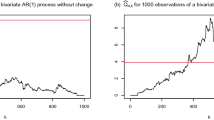We investigated change point detection (CPD) in time series composed of harmonic functions driven by Gaussian noise (in EEGs, in particular) and proposed a method of moving average filters in conjunction with wavelet transform. Numerical simulations showed that CPD runs over 90% within the frequency band <40 Hz. This means that detection of structural change points is almost guaranteed in the respective cases. The mean absolute error (MAE) as a measure of performance of the method was below 5%. The method is rather robust against noise. It has been demonstrated that CPD is possible at the noise amplitude exceeding 25% of the amplitude of harmonic functions. In application of the proposed method on the signals, CPD appeared in 74% of the analyzed EEGs.
Similar content being viewed by others
References
P. Yang, G. Dumont, and J. M. Ansermino, “Adaptive change detection in heart rate trend monitoring in anesthetized children,” IEEE Trans. Biomed. Eng., 53, No. 11, 2211–2219 (2006).
M. Staudacher, S. Telser, A. Amann, et al., “A new method for change-point detection developed for on-line analysis of the heart beat variability during sleep,” Physica A: Stat. Mech. Appl., 349, Nos. 3–4, 582–596 (2005).
S. M. Hammoudeh and H. Li. “Sudden changes in volatility in emerging markets: The case of Gulf Arab stock markets,” Int. Rev. Financ. Anal., 17, No. 1, 47–63 (2008).
J. Reeves, J. Chen, X. L. Wang, et al., “A review and comparison of change point detection techniques for climate data,” J. Appl. Meteorol. Climatol., 46, 900–915 (2007).
H. C. Ombao, J. A. Raz, R. von Sachs, and B. A. Malow, “Automatic statistical analysis of bivariate nonstationary time series. In Memory of Jonathan A. Raz,” J. Am. Stat. Assoc., 96, No. 45, 543–560 (2001).
D. Donoho, S. Malat, and R. von Sachs, “Estimating covariances of locally stationary processes: Rates of convergence of best basis methods,” in: Technical Report, Stanford Univ., Dept. of Statistics (1998), p. 517.
M. Latka, Z. Was, A. Kozik, and J. B. Wes, “Wavelet analysis of epileptic spike,” Physiol. Rev., Ser. E, 67, 052902/1-052902/4 (2003).
S. Aminikhanghahi and D. J. Cook, “A survey of methods for time series change point detection,” Knowl. Inform. Syst., 51, No. 2, 339–367 (2017).
G. Schalk, D. J. McFarland,T. Hinterberger, et al., “BCI2000: a general-purpose brain-computer interface (BCI) system,” IEEE Trans. Biomed. Eng., 51, No. 6, 1034–1043 (2004).
A. L. Goldberger, L. A. Amaral, L. Glass, et al., “PhysioBank, PhysioToolkit, and PhysioNet : Components of a new research resource for complex physiologic signals,” Circulation, 101, No. 23, 215–220 (2010).
W. Ploberger and W. Krämer, “The CUSUM test with OLS residuals (ordinary least squares),” Econometrica, 60, No. 2, 271–285 (1992).
E. S. Page, “Continuous inspection schemes,” Biometrika, 41, No. 1/2, 100–115 (1954).
S. Vanhatalo, M. J. Palva, D. M. Holmes, et al., “Infraslow oscillations modulate excitability and interictal epileptic activity in the human cortex during sleep,” Proc. Natl. Acad. Sci. USA, 101, No. 14, 5053–5057 (2004).
M. Last and R. Shumway, “Detecting abrupt changes in a piecewise locally stationary time series,” J. Multivar. Anal., 99, No. 2, 191–214 (2008).
Author information
Authors and Affiliations
Corresponding author
Rights and permissions
About this article
Cite this article
Keković, G., Sekulić, S. Detection of Change Points in Time Series with Moving Average Filters and Wavelet Transform: Application to EEG Signals. Neurophysiology 51, 2–8 (2019). https://doi.org/10.1007/s11062-019-09783-y
Received:
Published:
Issue Date:
DOI: https://doi.org/10.1007/s11062-019-09783-y




